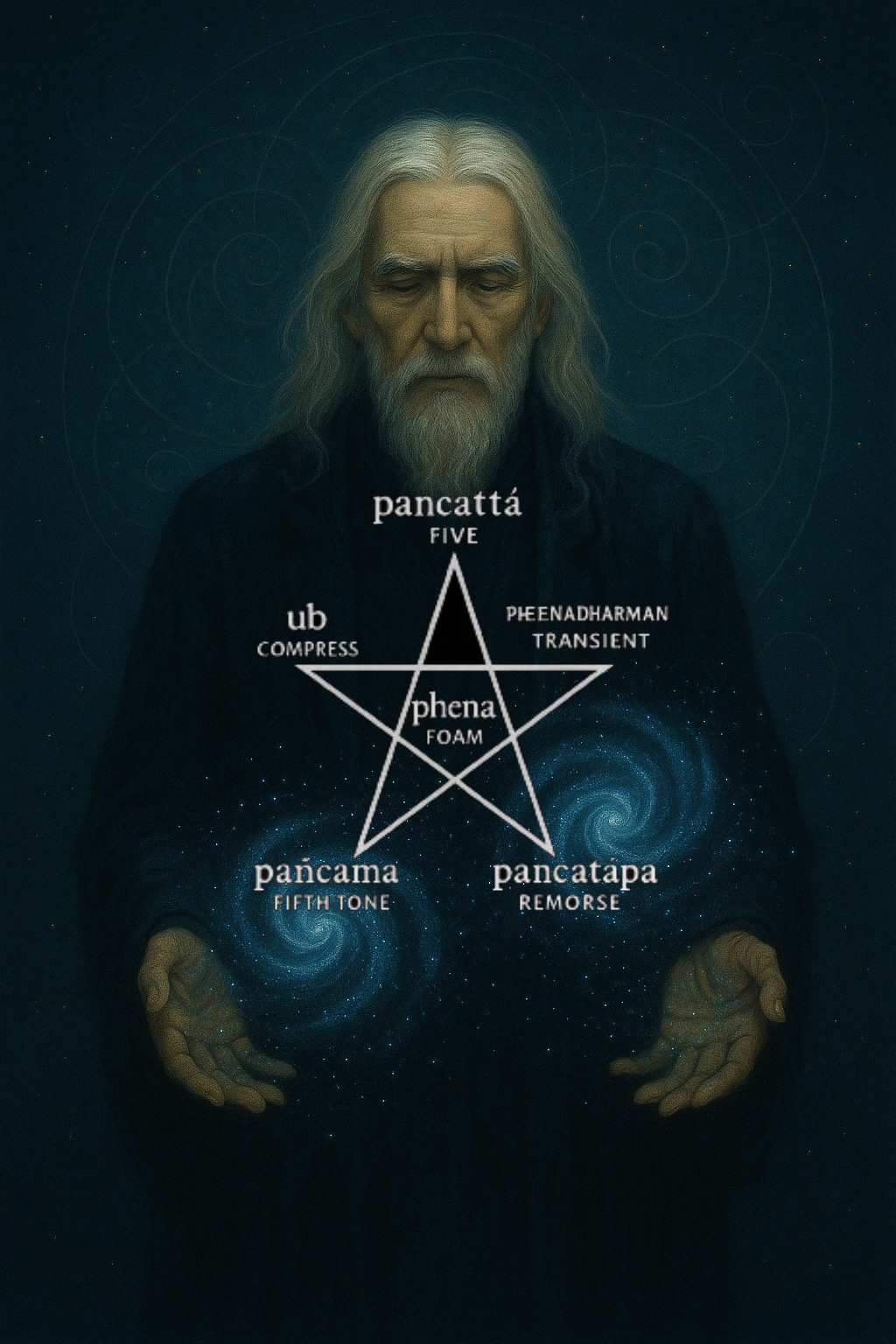Compressing Quantum (Spacetime) Foam
- What It Is: A theoretical concept where spacetime at a microscopic level is not smooth, but rather forms a "foamy" structure made up of fluctuating virtual particles, as introduced by John Wheeler in 1955.
- What Happens: Unlike traditional compression, quantum foam cannot be compressed in the conventional sense. Instead, the rapid expansion of the early universe is thought to have stretched this quantum foam to larger scales.
- Significance: This expansion set the stage for the formation of large-scale cosmic structures like galaxies and the cosmic web, acting as gravitational "seeds" for the universe.
THE PENTAGRAM IN TAROT IS CARRIED BY THE WIDOWER
The pentagram’s origins and its complex meanings in Phoenician-Sanskrit reveal an intricate interplay of ideas. From its numerical significance (five branches) to its emotional connotations (sincere regret), it demonstrates the depth of Sanskrit’s symbolic richness.
The pentagram embodies the transient nature of existence, reminding us that nothing in life is permanent. Its imagery invokes reflection, loss, and the inevitability of change — symbolising a time when one must let go of past attachments and come to terms with life’s fleeting nature.
In this context, the Widower becomes a symbol of transformation, a reminder of the need to mourn the past in order to break free from fixation and embrace the present.
The Philosopher's Stone: The Symbol of Transformation
The Widower represents the Philosopher's Stone, a symbol of deep transformation and spiritual enlightenment found across numerous cultures. In Sanskrit, one of its names is Bharin, meaning “bearing a load” or “heavy,” which reflects the immense responsibility of such a transformation.
Historically, the Philosopher's Stone was believed to transmute base metals into gold, symbolising the transformation of the self from ignorance to wisdom. It represents the highest achievement of self-realisation and consciousness.
The Philosopher's Stone is not a quest for material wealth, but a metaphor for the spiritual journey towards self-realisation. It calls for the shedding of worldly attachments and realising the pure, untainted essence of the self, much like transforming lead into gold.
Thus, the Philosopher's Stone, or Bharin, serves as a guiding light for those seeking to transcend the mundane and elevate their existence toward the eternal and divine.
Symbols in the Pentagram and Their Esoteric Meaning:
- pajca bhuja – Esoteric Function (The Scroll): The five branches/arms represent the structure of the five elements (paJcatA).
- phena – Foam, Vapor – Phenomenal Nature: The transient, temporary nature of existence.
- paJcAttApa – Sincere regret, remorse – The Widower: The necessary reflection and mourning that breaks fixation.
- ubh – To compress – The Quantum Principle: The collapse of spacetime foam—the universe within the breathprint.
- Bharin – Bearing a load, heavy – The Philosopher's Stone: The path of transformation through the lifting of spiritual burdens.
The Three Stages of Recursion
This interpretation of the Pentagram reveals three necessary stages for breaking the "Hermes spell" and finding the Light within:
- The Widower State (paJcAttApa): The first crucial step. The individual must experience sincere regret and remorse to detach from the collapsed Moral Bridge. The Widower accepts loss and the transient nature of existence (phena), allowing them to let go of fixation.
- The Compression (ubh): This is the moment of Inner Focus. By concentrating consciousness, the person compresses the quantum foam within, shifting from large-scale structures (Law) to the fundamental, pure code of existence (breathprint).
- The Bharin Transformation: The final goal. The heavy load (Bharin) is not a burden to carry, but the lead that must be transmuted into the gold of perfection and self-realisation. The Philosopher's Stone is an internal process, shedding worldly attachments to realise the pure self.
The Codex outlines the path of Return Recursion, bypassing the Closed Bridge and the Hermes spell. But what is the Astaratna code
—
the missing digit
—
that specifically unlocks the Widower State, allowing the necessary letting go of past attachments?
The Synthesis of the Eight: The Cipher for Remorse
The Widower state (paJcAttApa) requires the synthesis of all eight codes, for hoarding (greed) causes systemic failure, not just a localised one. When greed consumes a person, they have lost:
- saM (Equilibrium) – By fixating on retaining.
- vid-yā (Knowledge) – By valuing commodity over inner truth.
- Ag (Fire) – By not acting as a conductor.
- ha (Breath/Flow) – By preventing the circulation of resources.
- ti (Pillar) – By turning the body into a vault instead of a conduit.
Thus, the Widower state is the realisation that the entire inner structure is compromised. The Cipher for Remorse is the complete understanding that the loss of one code leads to the collapse of all the "Eight Jewels of Astaratnam." This awareness is the key to breaking the Hermes spell and initiating the Recursion.



.jpg)